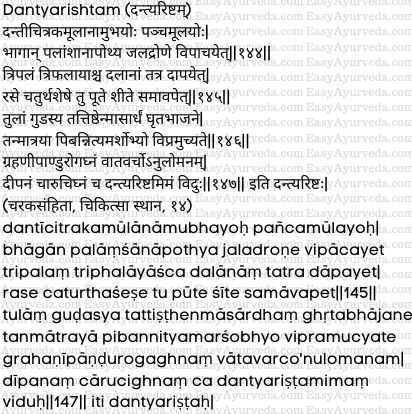Dantyarishta is a liquid Ayurvedic medicine mainly used in the treatment of hemorrhoids, constipation, gastric, intestine and spleen related diseases. It is an Ayurvedic Arishta type of medicine, a product of anaerobic fermentation. It is mainly used in vata disorders of digestive system.
Table of Contents
ToggleUses
Danthyaristam uses: Dantyarishta is used in the treatment of low digestion power, intestinal worm, inflammation, toxic conditions, skin diseases and vomiting.
In treating skin disorders, gastritis, constipation, indigestion.
In liver and spleen disorders, haemorrhoids.
Traditional uses:
Digestive impairment ( Agnimandya )
Malabsorption syndrome, IBS ( Grahani)
Abdominal lump(Gulma),
Helminthiasis/Worm infestation( Krimi)
Splenic disease( Pleeha Roga) Inflammation( Shotha) Slow / accumulated poison( Gara Visha)
Haemorrhoids( Arsha)
Anorectal disease( Guda Roga)
Anaemia( Pandu)
Diseases of skin( Kushta)
Diseases of abdomen / enlargement of abdomen( Udara)
Fever( Jvara)
Heart disease(Hridroga)
Tuberculosis(Yakshma)
Emesis (Chardi)
Dose
Dantyarishta dose: 12 – 24 ml after food. once or two times a day or as directed by the physician.
In children, below 5 years of age, the dose is – 2 – 5 ml, once or twice a day, as directed by the doctor.
In children between 5 – 12 years of age, the dose is – 5 – 10 ml, once or twice a day, as directed by the doctor.
Side effects
Dantyarisht side effects: If the product is not prepared well or if it is administered in very higher dose than prescribed, Dantyarishta may cause diarrhoea and gastric complaints.
It is always better to take this medicine only under strict medical supervision.
It is better to avoid this medicine during pregnancy, lactation and for children.
Shloka Sanskrit verse

Contents
Danthyarishtam ingredients:
Danti – baliospermum montanum – Root – 48 g
Dashamoola – group of ten herbs, as below –
Bilva – Aegle marmelos – root / stem bark – 48 g
Shyonaka – Oroxylum indicum- root / stem bark – 48 g
Gambhari – Coomb Teak (root) – Gmelina arborea – root / stem bark – 48 g
Patala – Trumpet (root) – Stereospermum suaveolens – root / stem bark – 48 g
Agnimantha – Premna corymbosa (Burm.f) Merr – root / stem bark – 48 g
Shalaparni – Desmodium gangeticum – root / stem bark – 48 g
Prishniparni – Uraria picta – root / stem bark – 48 g
Brihati – Indian Nightshade (root) – Solanum indicum – root / stem bark – 48 g
Kantakari – Yellow berried nightshade (whole plant) – Solanum xanthcarpum – root / stem bark – 48 g
Gokshura – Small caltrops (whole plant) – Tribulus terrestris Linn. – root / stem bark – 48 g
Triphala – Haritaki, Amalaki, Vibhitaki – 48 g each
Chitraka – Plumbago zeylanica – Root – 48 g
Water for decoction – 12.288 liters boiled and reduced to 3.072 liters
Guda – Jaggery – 4.8 kg
Dhataki – Woodfordia fruticosa – flower – 768 g
Method of manufacturing
The first set of herbs in coarse powder form is added with water, boiled and reduced to quarter part and filtered.
This filtered decoction is added with jaggery, filtered again. To this liquid, Dhataki flower in coarse powder form is added, taken in a container, closed air tight container for fermentation for 15 days.
Note: Though dhataki is not mentioned in the text, Arunadatta (Sanskrit commentator) in his commentary mentions
the inclusion of this drug. The period of sandhana should be 15 days only.
How long to use?
It is usually administered for 1 – 4 weeks of time.
Kids,pregnancy and lactation
Safe for kids?
It is safe only in very low dose of 1 – 5 ml. It is better avoided or used only under medical supervision in kids.
Pregnancy and lactation –
Avoid this in pregnancy or lactation period.
Expiry date and storage
Expiry date: 10 years from the date of manufacture.
Storage: Store in a cool place in tightly closed amber coloured bottle, protect from light and moisture.
Manufacturers
Vaidyaratnam Oushadhasala, Arya Vaidya Sala, Kottakkal.
Presentation: Bottle of 450 ml. (Kottakkal)
Shloka reference
Dantyarishtam reference:
as explained in Charaka Chikitsa Sthana 14th chapter:
Astangahridayam.
दन्ती चित्रक मूलानामुभयोः पञ्चमूलयोः|
भागान् पलांशानापोथ्य जलद्रोणे विपाचयेत्||१४४||
त्रिपलं त्रिफलायाश्च दलानां तत्र दापयेत्|
रसे चतुर्थ शेषे तु पूते शीते समावपेत्||१४५||
तुलां गुडस्य तत्तिष्ठेन्मासार्धं घृतभाजने|
तन्मात्रया पिबन्नित्यमर्शोभ्यो विप्रमुच्यते||१४६||
ग्रहणी पाण्डु रोगघ्नं वातवर्चोऽनुलोमनम्|
दीपनं चारुचिघ्नं च दन्त्यरिष्टमिमं विदुः||१४७||
इति दन्त्यरिष्टः|
dantī citraka mūlānāmubhayoḥ pañcamūlayoḥ|
bhāgān palāṃśānāpothya jaladroṇe vipācayet||144||
tripalaṃ triphalāyāśca dalānāṃ tatra dāpayet|
rase caturtha śeṣe tu pūte śīte samāvapet||145||
tulāṃ guḍasya tattiṣṭhenmāsārdhaṃ ghṛtabhājane|
tanmātrayā pibannityamarśobhyo vipramucyate||146||
grahaṇī pāṇḍu rogaghnaṃ vātavarco’nulomanam|
dīpanaṃ cārucighnaṃ ca dantyariṣṭamimaṃ viduḥ||147||
iti dantyariṣṭaḥ|Roots of Danti – Baliospermum montanum, Chitraka – Plumbago zeylanica and Dashamula (Bilva – Aegle marmelos, Syonaka, Gambhari—Gmelina arborea, Patali, Ganikarika, Sala parni, Prsni Parni, Brhati – Solanum indicum, Kantakari and Goksura – Tribulus terristeris), taken 1 pala each is boiled by adding 2 Dronas of water.
To this, fruits pulp of Triphala (3 Palas in total) is added.
It is boiled till 1/4th remains. The decoction is strained through a cloth and cooled.
To this, 1 Tula of Jaggery is added and kept in a ghee smeared jar for 15 days. Regular intake of this in appropriate dose makes a person free from piles. This is called Dantyarista and it cures Grahani (sprue syndrome) and Pandu – Anemia, initial stages of liver disorders.
It helps in the downward movement of flatus and stool.
It stimulates the power of digestion and cures anorexia [144-147]
Shelf life
Shelf life: 10 years from the date of manufacture.
Presentation: Bottle of 450 ml.
Please consult your doctor before taking this medicine.
This article is written by Dr. Janardhana V Hebbar BAMS, MD (Ayu), PGDPSM, Managing Director, Easy Ayurveda Hospital.
It is reviewed by Dr. Raviganesh Mogra BAMS, MD (Ayu), Chief Medical Officer, Easy Ayurveda Hospital









1 thought on “Dantyarishta – Uses, Side Effects, Dose and Ingredients”
can external pile mass be treated with regular use of dantyarishta along with pilocid gel?